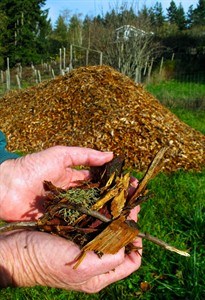
This Monday, Nov. 11, 2013 photo shows arborist chips, a back to nature mulch in Langley, Wash. Like many other organic materials, the chips help maintain soil moisture, prevent weeds from sprouting and keeps soil temperatures relatively constant around plants. They can rob soil of nitrogen, however, and fertilizer should be added as a supplement. (AP Photo/Dean Fosdick)
November 18, 2013 - 8:24 AM
Compost or mulch? People often confuse the two, although each fulfills a different function in gardening.
Which one you want depends on your needs.
"Compost is used to feed crops; mulch is used to suppress weeds," said Daniel McGrath, a horticulturist with Oregon State University Extension. "Compost is decomposed organic matter that is generally higher in nutrients and relatively low in carbon compared to mulch. Mulch is raw, un-decomposed organic matter."
Unlike compost, mulch is generally not mixed into the soil, he noted, but is applied 2 to 4 inches deep on top of the soil around a tree or shrub.
Mulch has fewer nutrients and is not meant to replace fertilizer, which should be added as a supplement. Mulching does, however, maintain soil moisture, prevent most weed seeds from germinating and keep soil temperatures constant around plants, said Martha Smith, an extension horticulturist with the University of Illinois.
Which kind of mulch you choose depends on what you're growing and where.
Some mulch, especially crushed rock and commercially made, colour-enhanced mixtures, can beautify pathways, driveways and play areas. Good mulch is easy to apply and remove; is free of noxious weeds, insects and disease; and adds organic materials to the soil as it breaks down.
"There are different byproducts used across the U.S. based on local supply," Smith said. That includes pine needles in the South, hazelnut shells in the Northwest and buckwheat hulls in the Southeast.
Some different mulch materials from which to choose:
— Shredded bark, wood chips and shavings. Easy to spread and long-lasting, but can rob the soil of nitrogen and make landscape plants turn yellow. Look for "arborist chips" or ground-up tree branches that can make a good mulch and often are available for the asking from tree trimmers.
— Gravel and stones. Stone doesn't have to be replaced like organic mulches, but it is expensive and will work into the ground. Stone is great for problem areas, though, like deep shade or in channels cut for stormwater runoff.
— Black plastic and straw. Both are commonly used in vegetable gardens and orchards. Plastics, however, prevent water from entering the soil, while straw contains grain seeds that can germinate.
— Leaves. Shredded leaves provide good insulation and weed control, although they won't allow much water to penetrate. Work them into the soil after they decompose.
— Others include newspapers (unattractive unless shredded), peat moss (inexpensive but acidic), shredded rubber (doesn't decompose but may smell) and landscape cloth (allows water to infiltrate but must be tacked down).
Some materials to avoid:
— Grass clippings, especially any containing herbicides. Clippings are better left on lawns where they break down quickly and return some nutrients to the soil.
— Treated wood chips, charcoal and ash — especially barbeque briquettes and coal ash — may include compounds and chemicals harmful to pets and plants.
— Sawdust packs tightly and is unsightly.
___
Online:
For more on mulches and mulching, see this Cornell University fact sheet:
http://www.gardening.cornell.edu/factsheets/mulch/mulchland.html
You can contact Dean Fosdick at deanfosdick@netscape.net
News from © The Associated Press, 2013